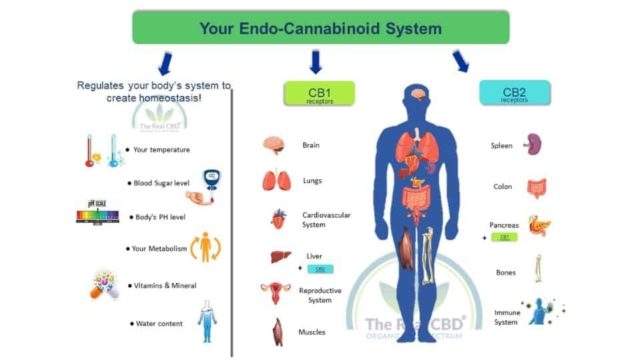CBD Oil for Pain Relief
To understand how CBD oil for pain relief works, through its interaction with the body’s endocannabinoid system (ECS) and its anti-inflammatory properties.
CBD oil, derived from the cannabis plant, has gained significant attention for its potential benefits in managing chronic pain. Although research on CBD is ongoing, evidence suggests its effectiveness in providing pain relief.
The endocannabinoid system is a complex network of receptors, enzymes, and endocannabinoids (cannabinoids produced naturally within the body). This system regulates various physiological processes, including pain perception, inflammation, and immune function. The ECS consists of two primary receptors, CB1 and CB2 receptors.
When CBD is consumed, it interacts with the endocannabinoid system in several ways:
Inhibiting enzymatic breakdown:
CBD can inhibit the enzyme called FAAH (fatty acid amide hydrolase), which breaks down anandamide, a natural cannabinoid in the body associated with pain regulation. By inhibiting FAAH, CBD increases anandamide levels, potentially enhancing its pain-relieving effects.
Modulating receptors:
CBD can indirectly affect CB1 and CB2 receptors in the endocannabinoid system. It may bind to receptors outside the ECS, such as TRPV1 receptors involved in pain and inflammation regulation. This interaction may influence pain perception and reduce inflammation.
Alleviating inflammation:
Chronic pain often involves underlying inflammation. CBD has been found to possess anti-inflammatory properties by interacting with various receptors and pathways in the body. By reducing inflammation, CBD oil may help alleviate pain associated with arthritis, neuropathy, and fibromyalgia.
Influencing neurotransmitters:
CBD may interact with neurotransmitters in the brain, such as serotonin and anandamide. Serotonin plays a role in mood regulation, and anandamide is associated with pain modulation. CBD oil might relieve pain and improve overall well-being by influencing these neurotransmitters.
It’s important to note that while CBD oil for chronic pain shows promise, more research is needed to understand its full potential and optimal usage. Dosing, product quality, individual physiology, and the specific condition addressed can influence its effectiveness.
Before using CBD oil for pain relief, it is advisable to consult with a healthcare professional who can provide guidance tailored to your specific needs and circumstances. They can help determine appropriate dosing and potential interactions with medications and discuss other pain management options.

The Mechanisms by which CBD Interacts with the Body’s Endocannabinoid System.
CBD interacts with the body’s endocannabinoid system (ECS) through various mechanisms. The ECS consists of three main components: endocannabinoids (cannabinoids produced naturally in the body), receptors, and enzymes.
Receptors:
CBD interacts with CB1 and CB2 receptors, although its interaction with these receptors is indirect and more complex than THC, the psychoactive compound found in cannabis. CB1 receptors are primarily located in the brain and central nervous system, while CB2 receptors are predominantly found in immune cells and peripheral tissues. CBD has a low affinity for these receptors but can influence their activity differently.
Enzymes:
CBD affects the enzymes involved in the breakdown and synthesis of endocannabinoids. One of these enzymes is FAAH (fatty acid amide hydrolase), which breaks down anandamide, an endocannabinoid associated with pain regulation. CBD inhibits FAAH, allowing anandamide to accumulate and potentially enhance its pain-relieving effects.
Modulating receptor signaling:
CBD can indirectly modulate CB1 and CB2 receptors’ signaling. It doesn’t directly bind to these receptors but can influence their activity through allosteric modulation. Allosteric modulation means that CBD can bind to a different site on the receptor, altering its shape and affecting its interaction with other compounds. This modulation can impact neurotransmitter release, resulting in various physiological effects.
Interacting with non-ECS receptors:
CBD interacts with receptors outside the ECS, such as TRPV1 receptors (transient receptor potential vanilloid 1). These receptors are involved in pain perception and inflammation regulation. CBD can activate or inhibit TRPV1 receptors, contributing to its possible analgesic and anti-inflammatory effects.
Serotonin receptors:
CBD also interacts with serotonin receptors, particularly the 5-HT1A receptor. This interaction may influence serotonin levels, which affect mood regulation and pain perception. CBD might contribute to its anxiolytic and analgesic properties by modulating serotonin receptors.
It’s important to note that the mechanisms of CBD’s interaction with the ECS are still being researched, and the full extent of its effects still needs to be fully understood.
Moreover, the results of CBD oil for chronic pain can vary depending on the concentration used, the specific formulation, and individual differences in metabolism and physiology. Further research is needed to comprehensively understand how CBD interacts with the ECS and other systems in the body.

How Does it Alleviate Pain Symptoms?
CBD may alleviate pain symptoms through multiple mechanisms:
Anti-inflammatory effects: Chronic pain often involves underlying inflammation. CBD has been shown to have anti-inflammatory properties by interacting with various receptors and pathways in the body. By reducing inflammation, CBD may help alleviate pain associated with arthritis, neuropathy, and fibromyalgia.
Modulation of pain perception:
CBD can influence pain perception by interacting with receptors involved in pain signaling. For example, it can interact with TRPV1 receptors, which play a role in transmitting pain signals. By modulating the activity of these receptors, CBD may reduce the intensity of pain signals sent to the brain.
Endocannabinoid system regulation:
CBD interacts with the endocannabinoid system (ECS), which plays a role in pain modulation. By inhibiting the breakdown of anandamide (an endocannabinoid associated with pain regulation) and increasing its levels, CBD may enhance the pain-relieving effects of the ECS.
Serotonin modulation:
CBD interacts with serotonin receptors, particularly the 5-HT1A receptor, in pain perception and mood regulation. By modulating serotonin levels and receptor activity, CBD may influence pain perception and provide relief.
Interaction with other neurotransmitters:
CBD can interact with various neurotransmitter systems, such as dopamine and opioid. These interactions may contribute to its analgesic effects by influencing the transmission of pain signals.
It’s important to note that CBD’s pain-alleviating effects can vary depending on factors such as the underlying cause of pain, the specific condition being treated, the dosage used, and individual variability. Additionally, CBD shows promise for pain relief but should not be considered a replacement for professional medical advice. It’s always advisable to consult with a healthcare professional before starting any new treatment for chronic pain.
User Testimonials and Anecdotal evidence
User testimonials and anecdotal evidence are personal accounts provided by individuals who have used CBD oil for chronic pain relief. While these accounts can provide insights into people’s experiences, it’s essential to approach them with caution as they do not constitute scientific evidence.
Here are a few points to consider when evaluating user testimonials and anecdotal evidence:
Placebo effect:
The placebo effect can play a significant role in the perception of pain relief. When individuals have positive expectations about treatment, their subjective experience of pain may improve, even if the treatment itself has no physiological effect. It highlights the importance of conducting controlled studies to determine the true efficacy of CBD for pain relief.
Variability of responses:
People’s reactions to CBD can vary due to individual differences in metabolism, underlying health conditions, the dosage used, and the quality of the CBD product. What works for one person may not work for another, and vice versa. Considering the diverse range of experiences when evaluating anecdotal evidence is essential.
Lack of control and bias:
Anecdotal evidence is often self-reported and lacks rigorous controls and scientific methodologies in clinical studies. Additionally, people who share their experiences may be more likely to report positive outcomes, potentially introducing a selection bias. Negative experiences or lack of effectiveness may be underrepresented in anecdotal reports.
Limited generalizability:
Anecdotal evidence represents the experiences of a small subset of individuals and may not be representative of the broader population. It’s crucial to recognize that individual experiences may not reflect the average response or apply to everyone.
While anecdotal evidence can be informative and contribute to the existing body of knowledge, it cannot be solely relied upon to make definitive conclusions about the effectiveness of CBD oil for pain relief. Rigorous scientific research, including well-designed clinical trials, must provide more robust evidence on CBD’s efficacy, safety, optimal dosages, and potential side effects.
If you are considering using CBD oil for pain relief , it’s advisable to consult with a healthcare professional who can provide personalized guidance based on your specific needs and medical history. They can help you make informed decisions and consider a comprehensive approach to pain management.



